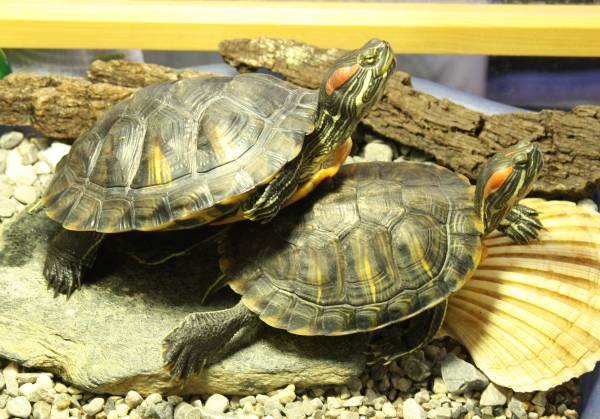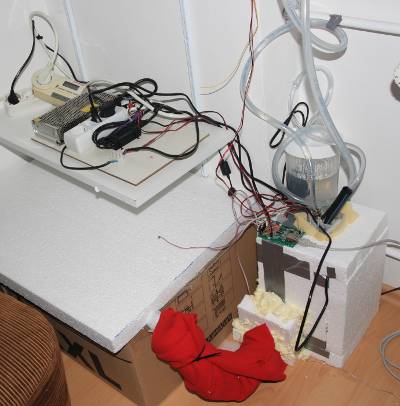Executive summary
We have two turtles who need to hibernate every winter. Last year it was very difficult (I over-engineered) but this year it’s looking better, and there’s cool graphs to monitor their health!
Our turtles and their home
We have two red snapper turtles, Arthur and Turok:

During the summer, they enjoy the huge (700l) aquarium in our living room

…but in the winter they should go into hibernation… They would survive without a yearly hibernation cycle, but it’s better for their health to go into hibernation.
Hibernation System 1.0
Last year I built a custom refrigerator:

This was a great learning experience (microcontroller programming, peltier elements, heat exchange, insulation, pumps, warm/cold water cycles…), but unfortunately not so effective… I was plagued with teething problems such as defective peltier elements, slime in the heat exchanger, ice crystalising in the warm water cycle… which resulted in a few unhealthy warm spikes in the otherwise stable “winter”…
Optimal hibernation
On recommendation from the local reptile institute we do the following hibernation sequence:
- Over a 4 week period reduce the hours of sunlight (150W full spectrum lamp over their island) and water temperature from the regular “summer” (10 hours/day at 25°C) to “winter” (3 hours/day at room temperature 20°C) over 6 weeks. The regular aquarium lighting is also reduced from 12 hours/day to 6 hours/day (we can’t afford to let the plants and fish go so dark…).
- Stop feeding 5 days before transfer to reduced activity phase.
- For the reduced activity phase before complete hibernation transfer from the large tank (we can’t cool such a huge mass of water in our living room any lower than room temperature) and place into a smaller tank at ~15C in the cellar with only one hour of light per day.
- Stay in reduced activity for about a week.
- Transfer into individual small tanks (just big enough so they can turn around) with water temperature at 12°C and water level just over the shell (so the turtle can easily lift head to breath if necessary, but is completely submerged otherwise) and place in the temperature controlled refrigerator.
- Reduce the temperature in the refrigerator by 1°C every 2 days until tank temperature is at about 6°C.
- Every 2-4 weeks during the ~4 months of hibernation:
- Change the water (should be done every week the first 3 weeks because they may still dirty the water with excrement, but it is ok if they don’t empty their bowels for hibernation!)
- Weigh the turtle (a total weight loss of up to 10% during hibernation is acceptable, any more and an early spring should be induced)
- Check for any signs of sickness
- About 3-4 months do the same again in reverse…
If like us you can’t give them the optimal lead-in to hibernation, they may not recognize the onset of winter, and are still active when (based on the temperature) they should already be sleeping. In this case, keep on track, and they will eventually (~2 weeks) fall asleep. Again – as long as they don’t loose more than 10% of their initial weight, it should be fine! You can also try reducing the temperature further (but not below 3°C as this will put them into a permanent sleep aka dead!)
Some people recommend continuing to feed the turtles during the “reduced activity” phase at 15°C. This is not a good idea because their digestive tract does not operate well at this temperature and puts a lot of strain on their liver. For their health it is better continue reducing the temperature and induce complete hibernation.
Hibernation Control System 2.0
So this year I decided to do it a bit less complex and use tried and tested cooling technology: the old 80’s fridge in my girlfriends parents cellar. The turtles need a very stable 4-8°C temperature to hibernate correctly. Unfortunately the temperature in most fridges fluctuates too much, and the warmest setting on the old one we have is much too cold (4°C at ±2°C), so I still needed a custom control system…
I retained the core control system: a network enabled micro controller I built two years ago with several temperature and humidity sensors. This time round rather than control a complex system of fans, pumps and peltier elements with it, I just hooked it up to a 230V relay to turn a regular power socket on and off, and plugged the old fridge into that socket… and it’s fantastically effective, and is much more efficient than last years system! 🙂
The software making the data visible
Using the powers of Dancer, Plack, Starman, and jqPlot, I put a small web app together to display the data. Here’s a post about implementing the web application.


